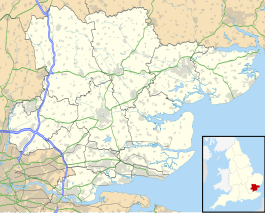Grange Hill is a London Underground station on the Central line which lies in the parish of Chigwell in the Epping Forest district of Essex. The boundary with the London Borough of Redbridge is immediately to the east of the station buildings. The station is between Hainault and Chigwell stations. The station has been in Travelcard Zone 4 since 2 January 2007.
| Grange Hill | |
|---|---|
 Entrance on Manor Road | |
| Location | Chigwell |
| Local authority | Epping Forest |
| Managed by | London Underground |
| Station code | GRH[1] |
| Number of platforms | 2 |
| Fare zone | 4 |
| London Underground annual entry and exit | |
| 2018 | |
| 2019 | |
| 2020 | |
| 2021 | |
| 2022 | |
| Key dates | |
| 1 May 1903 | Opened (GER) |
| 29 November 1947 | Closed (LNER) |
| 21 November 1948 | Opened (Central line) |
| 4 October 1965 | Goods yard closed[7] |
| Other information | |
| External links |
|
| WGS84 | 51°36′48″N 0°05′32″E / 51.61333°N 0.09222°E |
History edit
The station was opened by the Great Eastern Railway on 1 May 1903 on their Fairlop Loop line between Woodford and Ilford.
As a consequence of the 1921 Railways Act, the GER was merged with other railway companies in 1923 to become part of the London and North Eastern Railway (LNER). As part of the 1935–1940 New Works Programme of the London Passenger Transport Board the majority of the Woodford to Ilford loop was to be transferred to form the eastern extensions of the Central line. Although work commenced in 1938 it was suspended upon the outbreak of the Second World War in 1939 and work only recommenced in 1946. In connection with the alterations required for the electrification of the line, the station was closed from 29 November 1947. It reopened and was first served by the Central line from 21 November 1948. The station ticket office was reconstructed as part of this work following destruction of the original building by a German V1 'Doodlebug' in July 1944. The 1903 building was very similar to the next station to the north, Chigwell, which is still largely untouched to this day, and the original building further south at Newbury Park, demolished in 1956 to make way for a road improvement.
From the mid-1960s until the early 1990s the Woodford-Hainault section was largely separately operated from the rest of the Central line, using four car (later three car) trains of 1960 Stock. These trains were adapted for Automatic Train Operation (ATO); the Woodford-Hainault section became the testing ground for ATO on the Victoria line. The separate operation has now been abolished and through trains to Central London via Hainault now operate. At the beginning of the morning and evening peak periods, some trains starting from Hainault depot enter service at Grange Hill and work to central London via Woodford, although in the current timetable, only one train returns to Hainault depot via Grange Hill, the majority doing so instead via Newbury Park and Hainault.
Since 5 February 2006 this has been one of the small number of stations on the network to have no staffed ticket office.[citation needed] However, staff are available 24 hours a day for customer information and the train service has been extended to midnight to take into account the rising passenger numbers.
Services edit
Typical off-peak services are:
At morning rush hour, there are three trains that run to West Ruislip.[8]
| Preceding station | London Underground | Following station | ||
|---|---|---|---|---|
| Hainault Terminus
|
Central line Hainault-Woodford
|
Chigwell towards Woodford
| ||
| Historical railways | ||||
| Hainault Line and station open |
Great Eastern Railway Woodford and Ilford line |
Chigwell Line and station open | ||
Connections edit
London Buses routes 362 and 462 serve the station.
References edit
- ^ "Station Codes" (PDF). Transport for London. Retrieved 27 September 2021.
- ^ "Station Usage Data" (CSV). Usage Statistics for London Stations, 2018. Transport for London. 23 September 2020. Archived from the original on 14 January 2023. Retrieved 11 October 2023.
- ^ "Station Usage Data" (XLSX). Usage Statistics for London Stations, 2019. Transport for London. 23 September 2020. Archived from the original on 9 November 2020. Retrieved 9 November 2020.
- ^ "Station Usage Data" (XLSX). Usage Statistics for London Stations, 2020. Transport for London. 16 April 2021. Retrieved 1 January 2022.
- ^ "Station Usage Data" (XLSX). Usage Statistics for London Stations, 2021. Transport for London. 12 July 2022. Retrieved 7 September 2022.
- ^ "Station Usage Data" (XLSX). Usage Statistics for London Stations, 2022. Transport for London. 4 October 2023. Retrieved 10 October 2023.
- ^ Hardy, Brian, ed. (March 2011). "How it used to be – freight on The Underground 50 years ago". Underground News (591). London Underground Railway Society: 175–183. ISSN 0306-8617.
- ^ "Central Line timetable changes". 10 January 2020. Retrieved 7 February 2020.
